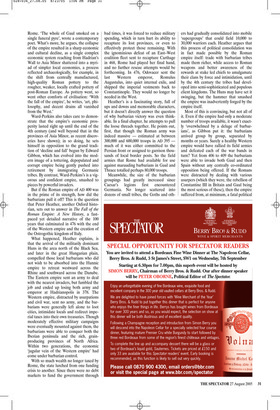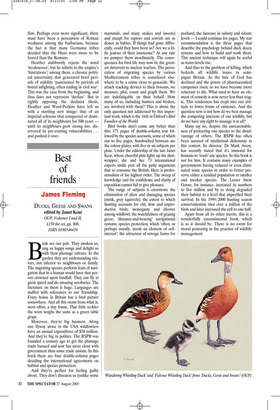Why Rome fell
Ian Garrick Mason
THE FALL OF ROME AND THE END OF CIVILIZATION by Bryan Ward-Perkins OUP, £14.99, pp. 239, ISBN 0192805649 ✆ £12.99 (plus £2.25 p&p) 0870 800 4848 THE FALL OF THE ROMAN EMPIRE: A NEW HISTORY by Peter Heather Macmillan, £25, pp. 572, ISBN 0333989147 ✆ £23 (plus £2.25 p&p) 0870 800 4848 In the decade before his death in 1982, the science-fiction writer Philip K. Dick was afflicted with a powerful delusion. He became convinced that the Roman empire was still in existence; that despite what was written in all the history books it had in fact never fallen. Nineteen-seventies California was merely a false projection, a fantasy world concocted to mask the ongoing and malevolent reality of Rome, AD 70.
Modern scholars of late antiquity do not suffer from this delusion. But many of them nonetheless argue that the Roman empire didn’t fall — rather, that it went through a ‘transformation’ from a Romanled civilisation into a Germanic-led one. Such a perspective deliberately avoids the temptation to treat the post-Roman successor states as uncivilised, acknowledges the continuity of Roman administrative practices, and gives the barbarians their due for arriving with semi-sophisticated cultures of their own.
Oxford historian Bryan Ward-Perkins, however, feels that these scholars go too far when they describe this process as one of peaceful immigration and accommodation — as the historian Walter Goffart did in 1980 when he wrote that ‘what we call the fall of the Western Roman empire was an imaginative experiment that got a little out of hand’. So in The Fall of Rome and the End of Civilization Ward-Perkins sets out to prove something no schoolchild would have thought to doubt in the first place: that the Roman empire really did fall.
And fell hard. Ward-Perkins deliberately emphasises the violence that attended invasion and collapse: the barbarians abducted farmers, raped nuns, sacked Rome. ‘The whole of Gaul smoked on a single funeral pyre’, wrote a contemporary poet. What’s more, he argues, the collapse of the empire resulted in a sharp economic and cultural decline, as a single complex economic system reaching from Hadrian’s Wall to Asia Minor shattered into a myriad of simpler local economies, a process reflected archaeologically, for example, in the shift from centrally manufactured, high-quality Roman pottery to the rougher, weaker, locally crafted pottery of post-Roman Europe. As pottery went, so went other comforts of civilisation: ‘With the fall of the empire’, he writes, ‘art, philosophy, and decent drains all vanished from the West.’ Ward-Perkins also takes care to demonstrate that the empire’s economic prosperity lasted right up until the end of the 4th century (and well beyond that in the provinces of Asia Minor, as recent discoveries have shown); in so doing, he sets himself in opposition to the grand tradition of ‘decline and fall’ begun by Edward Gibbon, which has evolved into the modern image of a tottering, depopulated and corrupt empire being gently pushed into retirement by immigrating Germanic tribes. By contrast, Ward-Perkins’s is a vigorous and confident empire, smashed to pieces by powerful invaders.
But if the Roman empire of AD 400 was in the prime of its strength, how did the barbarians pull it off? This is the question that Peter Heather, another Oxford historian, sets out to answer in The Fall of the Roman Empire: A New History, a fastpaced yet detailed narrative of the 100 years that culminated in 476 with the end of the Western empire and the creation of the Ostrogothic kingdom of Italy.
What happened, Heather explains, is that the arrival of the militarily dominant Huns in the area north of the Black Sea, and later in the great Hungarian plain, compelled those local barbarians who did not wish to be absorbed into the Hunnic empire to retreat westward across the Rhine and southward across the Danube. The Eastern empire sent an army to deal with the nearest invaders, but fumbled the job and ended up losing both army and emperor at Hadrianopolis in 378. The Western empire, distracted by usurpations and civil war, sent no army, and the barbarians were generally left alone to loot cities, intimidate locals and redirect imperial taxes into their own treasuries. Though moderately effective military campaigns were eventually mounted against them, the barbarians were able to conquer both the Iberian peninsula and the rich, grainproducing provinces of North Africa. Within two generations, the economic ‘jugular vein of the Western empire’ had come under barbarian control.
With so much wealth no longer taxed by Rome, the state lurched from one funding crisis to another. Since there were no debt markets to fund the government through bad times, it was forced to reduce military spending, which in turn hurt its ability to recapture its lost provinces, or even to effectively protect those remaining. With the ignominious defeat of an East–West coalition fleet sent to recapture Carthage in 468, Rome had played her final hand, and no further rescue attempts would be forthcoming. In 476, Odovacer sent the last Western emperor, Romulus Augustulus, into quiet internal exile, and shipped the imperial vestments back to Constantinople. They would no longer be needed in the West.
Heather’s is a fascinating story, full of ups and downs and memorable characters, but it doesn’t directly answer the question of why barbarian victory was even thinkable. In a final chapter, he attempts to pull the loose threads together. He points out, first, that though the Roman army was indeed massive — estimated at between 300,000 and 600,000 troops in AD 395 much of it was either committed to the Persian front or assigned to garrison thousands of local border posts. So the field armies that Rome had available for use against marauding barbarians in Gaul and Thrace totalled perhaps 80,000 troops.
Meanwhile, the size of the barbarian groupings had greatly increased since Caesar’s legions first encountered Germania. No longer scattered into dozens of small tribes, the Goths and oth ers had gradually consolidated into mobile ‘supergroups’ that could field 10,000 to 30,000 warriors each. Heather argues that this process of political consolidation was in fact made possible by the Roman empire itself: trade with barbarian tribes made them richer, while access to Roman weapons and better awareness of the rewards at stake led chiefs to amalgamate their clans by force and intimidation, until by the 4th century the tribes had developed into semi-sophisticated and populous client kingdoms. The Huns may have set it swinging, but the hammer that smashed the empire was inadvertently forged by the empire itself.
Most of this is convincing, but not all of it. Even if the empire had only a moderate number of troops available, it wasn’t exactly ‘overwhelmed by a deluge of barbarians’, as Gibbon put it: the barbarians arrived group by group, separated by months or years. Surely a healthy Western empire would have rallied its field armies and defeated each of the war bands in turn? Yet from 406 to 409 the barbarians were able to invade both Gaul and then Spain without any centrally co-ordinated opposition being offered. If the Romans were distracted by dealing with various usurpers (which they were, the rebellion of Constantine III in Britain and Gaul being the most serious of these), then the empire suffered from, at minimum, a fatal political flaw. Perhaps even more significant, there must have been a perception of Roman weakness among the barbarians, because the fact is that many Germanic tribes decided that the Huns were more to be feared than the Romans.
Heather stubbornly rejects the word ‘weaknesses’, but he admits to the empire’s ‘limitations’; among them, a chronic political uncertainty that generated brief periods of stability ‘punctuated by periods of brutal infighting, often ending in civil war’. This was the case from the beginning, and thus does not represent ‘decline’. But in rightly opposing the declinist thesis, Heather and Ward-Perkins have left us with a startling new image: that of an imperial colossus that conquered or dominated all of its neighbours for 500 years until its neighbours grew strong too, discovered its pre-existing vulnerabilities ... and pushed it over.













































 Previous page
Previous page